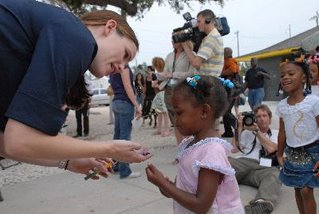Study: Students Displaced by Katrina Suffer

Many of the approximately 200,000 Louisiana students displaced from their public schools by Hurricanes Katrina and Rita may experience long-term academic problems, according to a RAND Corporation study.
The vast majority of the displaced students missed weeks or more of school due to the storms, and most did not return to their original schools by the end of the 2005-06 school year, according to the report prepared by RAND Education for the RAND Gulf States Policy Institute (RGSPI).
“Many children relocated to other schools or left the Louisiana public school system entirely,” says lead study author John Pane of RAND. “Most students missed a lot of school and many had to adjust to new environments, which might slow their academic progress.”
Moving children among schools has been associated with detrimental effects on academic achievement both for the students who move and for other students in the schools, Pane said. In addition to missing some time in school, the students who move may find themselves inadequately prepared for their new classes because the curriculum varies across schools. These problems are compounded by the need to adjust to new social environments and overcome the trauma of the disasters.
Using Louisiana's Student Information System and a survey of 415 school principals, researchers determined that more than a quarter of the state's 740,000 public school students were displaced by one of the hurricanes – the largest displacement of students in U.S. history.
Overall, more than 81 percent of the displaced Louisiana students came from one of three parishes: Orleans, Jefferson and Calcasieu.
The study found that 45 percent of displaced students eventually returned to their original schools, either directly or after enrolling elsewhere temporarily. Another 24 percent, who did not return to their original schools, enrolled elsewhere in the state.
“After their initial re-enrollment, many displaced students continued to change schools, and a substantial number left the state's public education system entirely,” says RAND researcher Dan McCaffrey, a co-author of the report. He said the median amount of time the affected students missed from school was five weeks.
In addition, minority students and those who had been faring poorly academically before the storms were disproportionately impacted, according to the study.
Researchers found that nearly 65 percent of the displaced students were members of minority groups. About 58 percent were black, 4 percent Hispanic, 3 percent Asian and less than 1 percent Native American. This compares to the 52 percent of all Louisiana public school students who are minorities.
Researchers said some students also experienced mental health and behavior problems due to the trauma that many youngsters experienced in the storms and their aftermath, including moving to new communities and schools.
The study by RAND, a nonprofit research organization, found that the majority of principals surveyed indicated that the social behaviors of most displaced students were similar to those of students in the schools before the hurricanes hit.
But in a sizable portion of schools — particularly those serving a large number of displaced students — principals said they observed an increased level of student absenteeism, fights, verbal abuse of teachers, bullying, cutting class and theft. Displaced students were more likely to violate school rules, isolate themselves, and not participate in social activities like clubs or sports. They were also more likely to need mental health counseling.
Faculty members in Louisiana schools also experienced higher levels of work stress, job frustration and absenteeism, the study found. This resulted from the storms' effects on their own lives, as well as staffing shortfalls and strains on other key resources.
According to the report, class sizes increased in more than a third of the schools, and more than half of the schools needed more classroom teachers, special education teachers, support staff and counselors.
The study says problems that students and faculty faced during the 2005-06 school year are likely to persist. It recommends that schools continue helping students affected by the hurricanes with counseling and academic services, and also help teachers deal with their own hurricane-related problems.
“The plight of children in the face of tragedy is always a concern,” says Mike Ward, associate professor of educational leadership at the University of Southern Mississippi. “The report offers very useful insights into the experiences of students in the wake of these storms, along with recommendations to help reduce their suffering and that of students in subsequent disasters.”
Researchers found that about 53,000 of the displaced students never re-enrolled in Louisiana public schools, and another 10,000 dropped out by the end of the 2005-06 school year.
While many of these students enrolled in schools in other states, the lack of definitive tracking data makes it hard to determine where many went. Some students may not have gone back to school anywhere, losing nearly an entire year of schooling or dropping out of school.
The study says better state and national student information systems could help keep track of students who are displaced by future disasters, while also assisting in information sharing about proper placement and needed educational services, grade completion, test scores and other educational matters.
Labels: children, displaced, education, gulf states, Katrina, Louisiana, students


0 Comments:
Post a Comment
Subscribe to Post Comments [Atom]
<< Home